We can’t send you updates from Justia Onward without your email.
Unsubscribe at any time.
Are you investing in PPC advertising for your law firm? Maximize your return on this investment by leveraging landing pages tailored to your PPC campaigns. Check out this post to learn more about the basics of PPC landing pages for law firms.
When you spend your hard-earned marketing dollars on pay-per-click (PPC) advertising for your law firm, every click counts. Therefore, it is crucial that the potential new clients clicking on your ads land on specialized pages designed to convert, or in other words, call your firm or submit a contact form.
By optimizing your PPC landing pages, you increase your law firm’s return on investment and maximize the effectiveness of your campaign. As an illustration, one law firm client working with our Justia Amplify PPC management team saw a more than 245% increase in its conversion rate when switching to a tailored landing page for PPC campaigns, rather than solely linking its ads to its law firm website. This significant increase in total conversions was coupled with a 65% decrease in the overall cost per conversion for this firm.
If you want a crash course on one key way to improve your PPC campaign performance, read this post for a beginner’s introduction to effective PPC landing pages for law firms.
Landing Pages v. Your Law Firm Website Pages
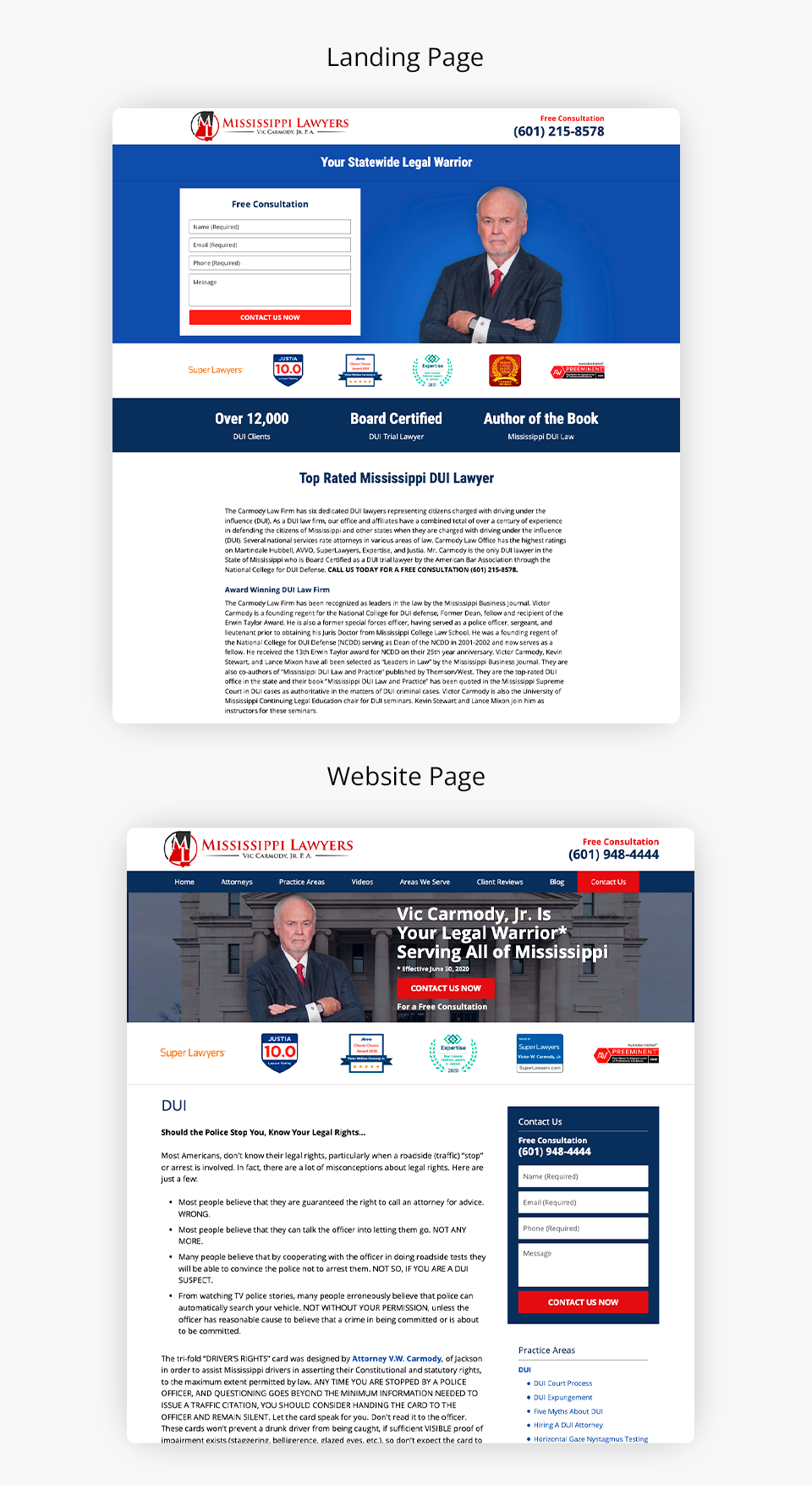
You likely invested a lot of time and effort into creating your law firm website. Naturally, you may be inclined to increase its exposure by also leveraging your website in your PPC campaigns. Unfortunately, using your standard website as the landing page for your PPC campaign can undermine your greater marketing success.
The strategies that work well for law firm website optimization are often mismatched with the objective of a PPC advertising campaign. In short, landing pages and websites serve different purposes and have distinct characteristics.
An effective law firm website is optimized for search engines and designed to target a broader spectrum of users with various intents. Your website is a long-term asset with a diverse mix of content, various objectives, and likely multiple calls-to-action (CTAs). It is indexed by search engines and designed to cover a wide range of keywords. While one objective of your website is undoubtedly to reach new clients, it may also be designed to educate the public, build your professional reputation with the larger community and legal profession, and serve as a resource for current clients.
In contrast, landing pages are typically a shorter-term campaign asset with a singular objective and often a singular CTA. They do not need to be, and typically are not, indexed by search engines and focus solely on providing concise information specifically tailored to the topic at hand – the content of your PPC ad. In contrast to an SEO-optimized website, landing pages narrowly focus on your target keywords. They are explicitly designed to solely turn paid clicks into new client leads. Your law firm’s PPC landing page’s primary goal will always be to guide users into contacting your law firm.
Watch this clip to learn more about PPC landing pages.
Crafting Your Law Firm Landing Pages
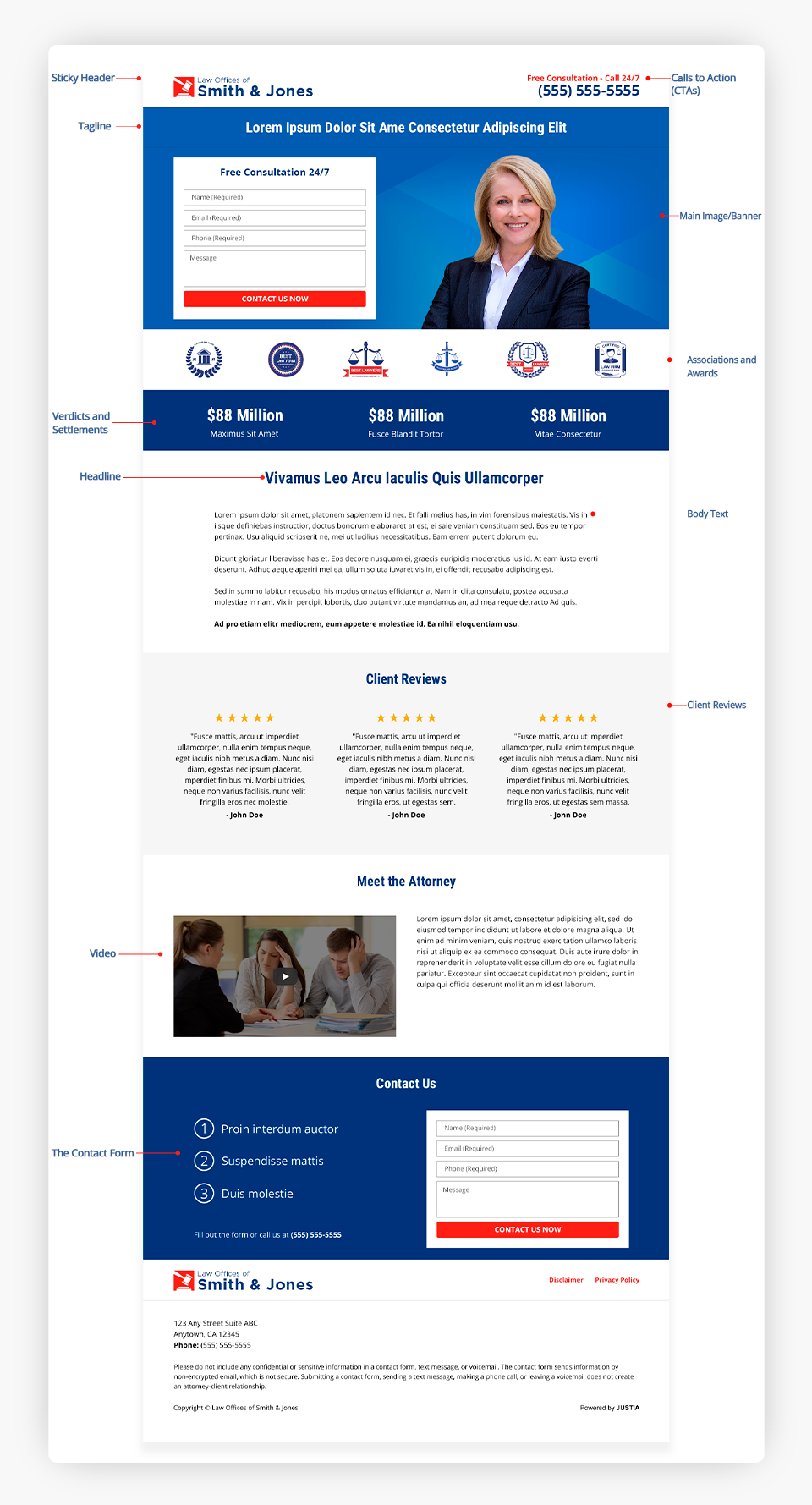
Following a formulaic approach to your landing pages can help your law firm ensure you are focused on factors that directly relate to your campaign success. By following the framework below, you set your law firm up for more successful PPC campaigns.
Calls to Action (CTAs)
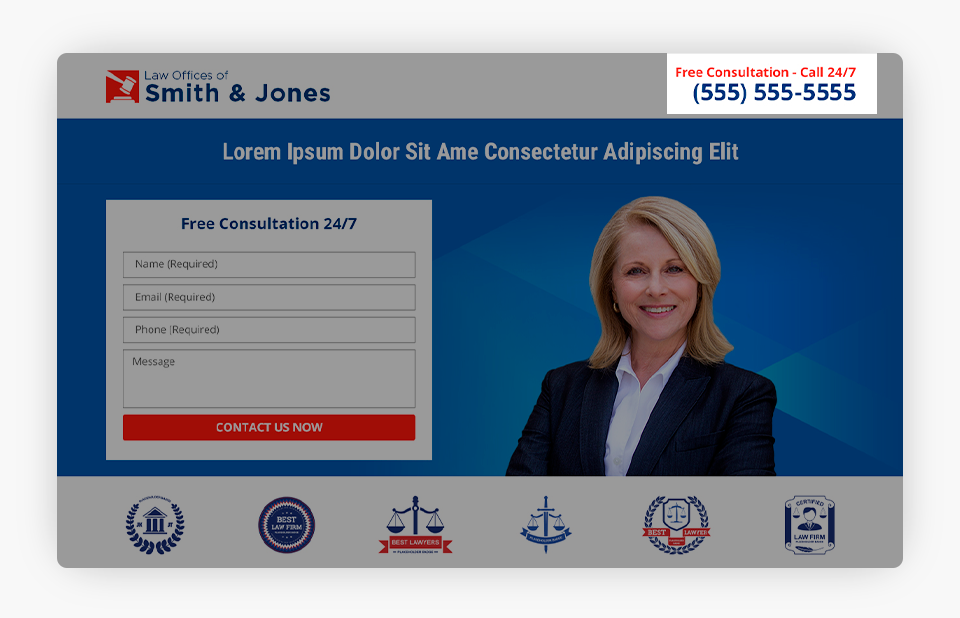
The primary purpose of PPC ads is to encourage potential clients to contact your law firm. Thoughtfully incorporating CTAs on your landing pages is important for optimizing and increasing your conversion rates. For instance, one consultant found that adding a CTA at the end of a long landing page could increase conversion rates up to 304%.
Why?
- Direction & Guidance: As referenced above, CTAs are intended to maximize your conversion rates. The CTAs on your page guide potential clients toward the next action you want them to take.
Without a clear CTA, visitors may not know what to do next. Any confusion about what a user should do upon landing on your landing page can result in lost lead opportunities and wasted ad spend. CTAs are a crucial element for turning visitors into leads for your law firm.
Additional Considerations
Be sure to use contrasting colors to increase the visibility of your CTAs and ensure they pop for your visitors. Well-designed, easily noticed buttons can significantly boost your conversion rates. If your CTAs are not working, try making simple adjustments to the color, font, size, and placement of these elements.
Sticky Header
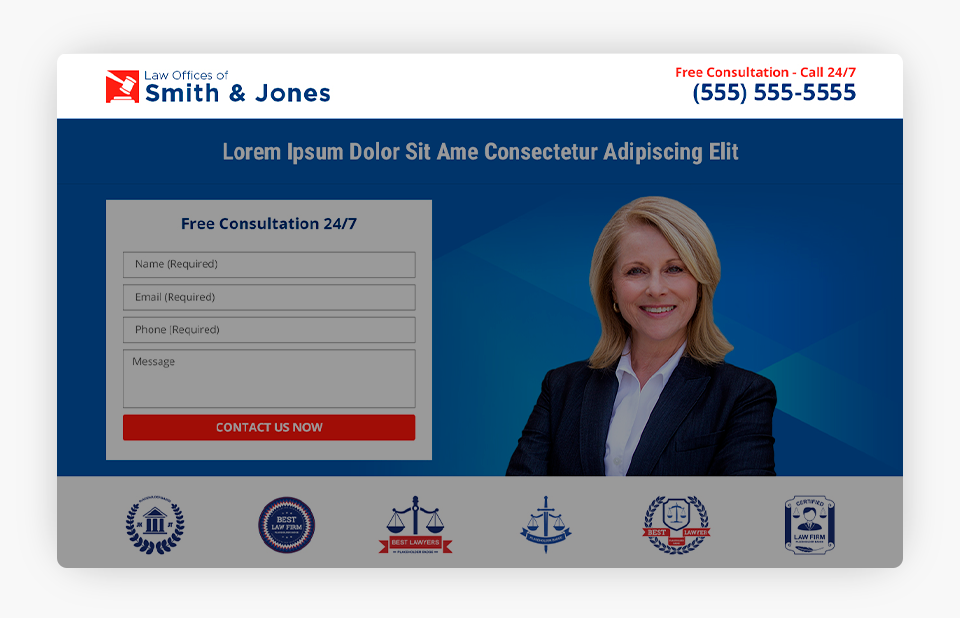
Your law firm PPC landing page needs to have a sticky header containing both your logo and a CTA inviting visitors to contact your firm.
You want to minimize exit points in this header, as any link not related to a conversion goal can divert your potential clients. Thus, this sticky header should not be the same navigation that you leverage on your website pages and needs to limit the actions to those that keep landing page visitors more focused on conversions.
Why?
- Branding: Keeping your logo at the top of the page as your potential clients scroll provides constant reinforcement of your firm’s brand to visitors. This creates better awareness and recognition for your firm. Plus, a professional logo increases the likelihood that visitors will have a positive first impression of your practice and add credibility to your landing page by assuring visitors they are in the right place.
- Encourage Action: Your sticky header keeps your CTA constantly visible, increasing the likelihood of a conversion while also subtly adding urgency to the action. Use a prominent, eye-catching color to ensure it is not overlooked.
- Ease of Navigation: To the extent your PPC landing page includes navigation elements, a sticky header improves the user experience by keeping the navigation within reach. You don’t want your users to have to scroll up to access the header. This is especially important on mobile devices, where leveraging a sticky header allows you to keep Tap to Call, or Tap to Text, buttons within reach.
Focusing on ease of navigation also helps reduce bounce rates by keeping important information and CTAs always accessible.
Additional Considerations
While a sticky header is beneficial for your law firm, it needs to be implemented properly to be effective. They should not take up too much space on the page, nor should they slow your page load speeds. They should be sleek and unobtrusive, while remaining easily distinguishable from the rest of the content on your page. Also, you should ensure elements, particularly buttons, are easily clicked on small screens.
Tagline
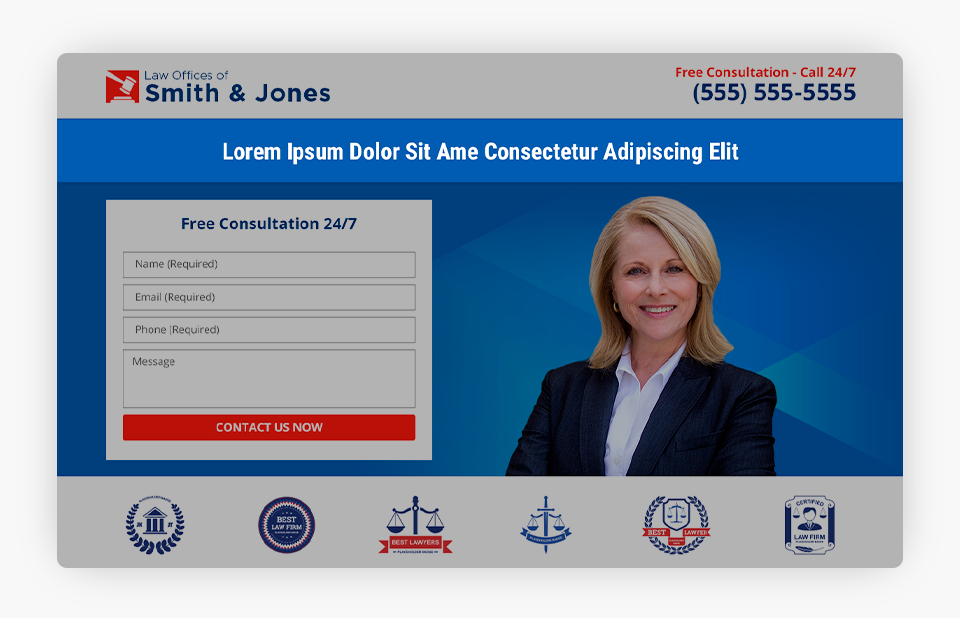
Your tagline is often used as the heading on your PPC landing page. It should be engaging marketing language that entices potential clients to learn more about your firm. You will want to ensure your language is impactful and effectively communicates your law firm’s value proposition.
Why?
- Make a Strong Impression: Your tagline is often the first text visitors notice on your landing page. Thus, it should be a short phrase that captures a visitor’s attention.
Additional Considerations
Try making your tagline match your user search queries. For instance, if you are running PPC ads for car accidents, try relating to that subject matter in the tagline used for your PPC landing page. Be sure this language is as engaging as possible.
Main Hero Image/Banner
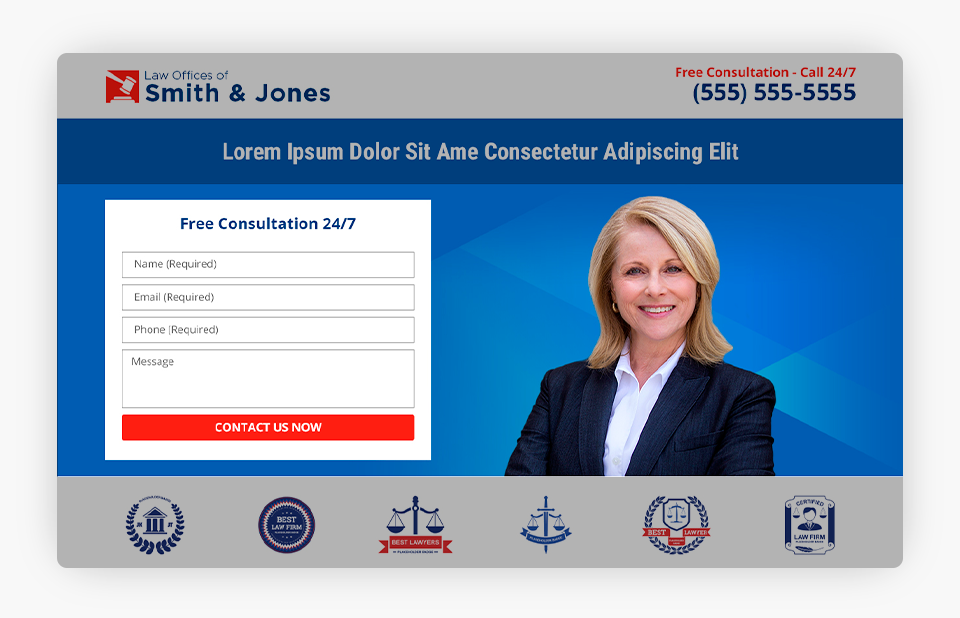
A good landing page will have a high-quality image as the main banner or “hero image”. These images help you break through the impersonality of the online world and create better connections with potential clients that, in turn, increase conversions.
Why?
- Build Trust: Visitors will often feel more connected to your firm through images, which can increase engagement and conversions. Real images of you and your team portray an authenticity that resonates more with potential clients. Remember, your potential clients are often dealing with sensitive issues and want to be assured they are dealing with a real person.
- Professionalism: A high-quality banner image conveys professionalism and dedication to your audience. This subconsciously suggests to clients that you take your work seriously.
- Differentiation: If done right, your banner image is unique to your firm and sets you apart from your competitors. A strong image also reinforces your unique brand, so we recommend hiring a professional photographer to take a high-quality photo of you or your team to use on your landing pages.
Additional Considerations
Try using an image of people or your actual headshot in the main image. People respond to people, and data indicates that friendly and welcoming faces increase conversion rates on online platforms.
However, avoid stock photos when possible. These can sometimes be perceived as generic or insincere. Plus, they may be used by other lawyers and undermine your efforts at differentiating your firm from your competitors.
The Contact Form
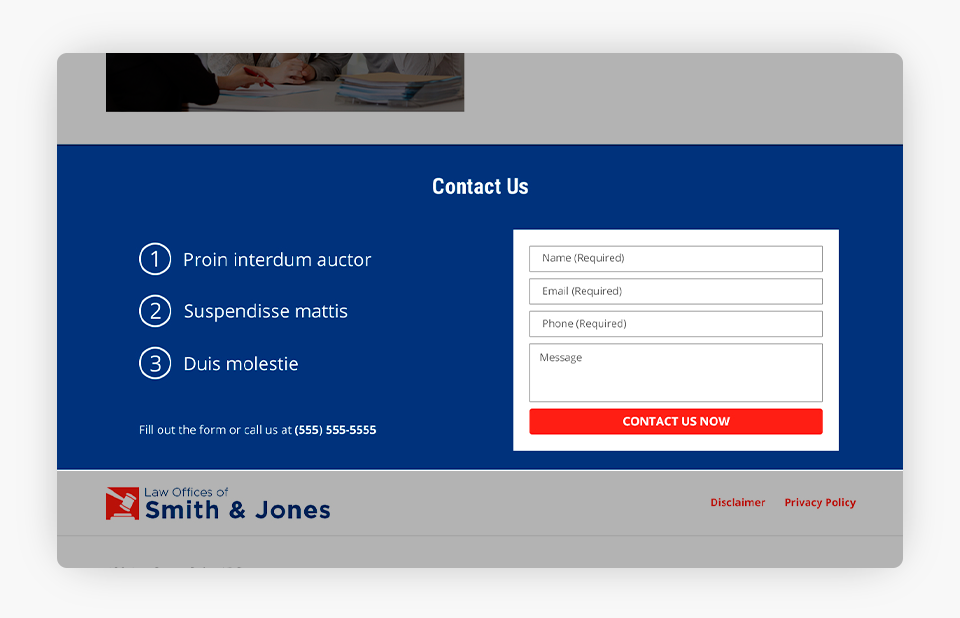
When leveraging PPC advertising, your law firm’s goal is indisputably to reach more clients. Thus, the contact form is arguably one of the most important parts of the landing page used for your law firm PPC ads. It needs to be included prominently on the page and above the fold.
You should also add a bottom contact form to your page that is slightly different from your top form and reinforces the “selling” points of your practice for your potential clients.
Why?
- Ease of Contact: If you want visitors to your landing page to contact you, it needs to be obvious and easy. Thus, including your contact form above the fold is crucial for success and optimizing your conversion rates. Likewise, giving clients another easy chance to contact you when they are finished scrolling the page is equally as important.
Additional Considerations
To improve your conversion rates, only add contact form fields that are essential. You don’t want to overwhelm visitors with a long form. Usually, name, phone number, and email address are enough for the standard law firm contact form.
Differentiate the bottom contact form on your page by reinforcing your law firm’s unique selling points in a numbered list.
Associations and Awards
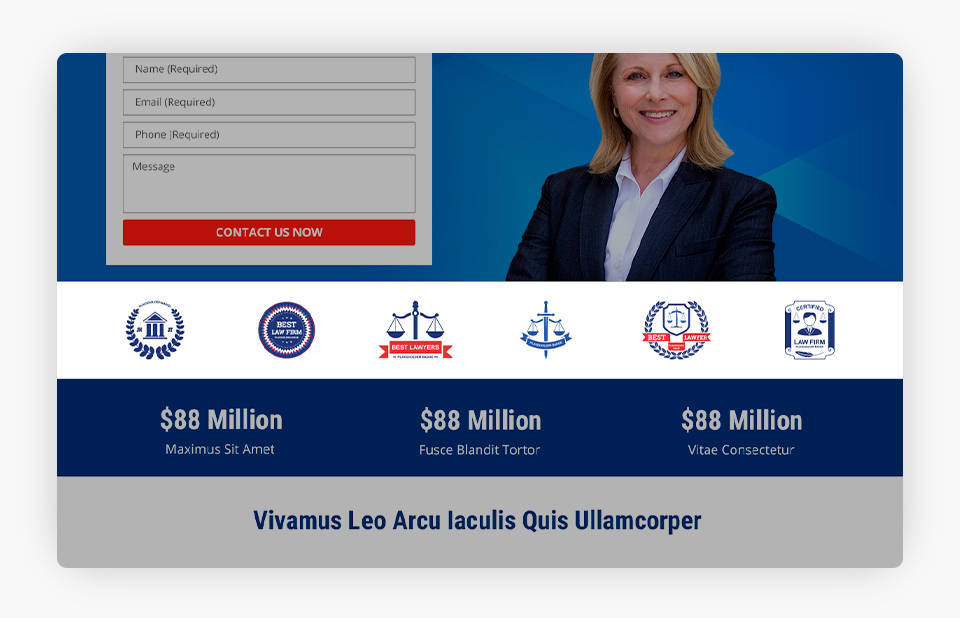
External validation of your ability or social proof is the digital version of the traditional referral. You should feature compelling associations to which you belong or awards you have earned on your PPC landing pages.
Why?
- Build Trust: Potential clients are curious about you. Remember, you are a stranger to them. Recognition from reputable institutions can build trust with them and increase their confidence in your skills.
- Outshine Competitors: One of the key parts of marketing a law practice is ensuring you set yourself apart from your competitors. Recognition from external organizations and the associations to which you belong can help differentiate your law firm from the guy next door.
Additional Considerations
Be sure you list awards and associations that lend themselves to your professional credentials and legal acumen. You have a limited amount of space and want to keep clients focused on awards from recognized entities and membership in organizations that tie into your professional reputation.
Verdicts and Settlements
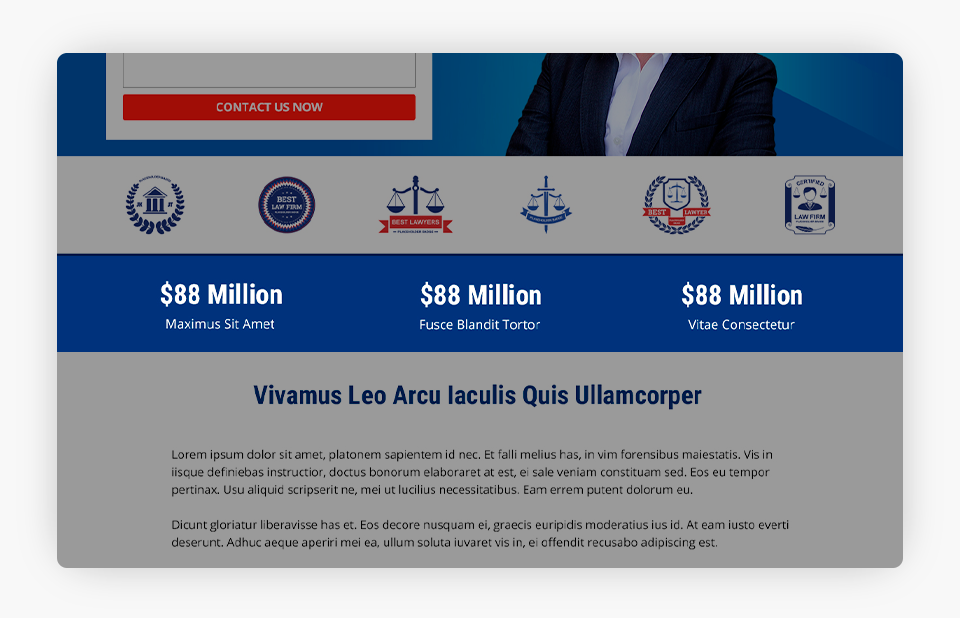
Selling your success is important in legal marketing. You want to ensure your PPC landing pages highlight your success stories, such as cases won and favorable settlements achieved.
Why?
- Build Client Confidence: Your clients come to you looking for help with what are often difficult situations, and they want success. Showcasing your prior success builds their confidence in your skills and their choice to contact your law firm. When clients trust that you can help them, they are more likely to reach out.
Additional Considerations
While success of all kinds can be a powerful tool in marketing your practice, try to focus on verdicts and settlements that pertain to the specific practice area that is connected to your ad.
For instance, if your ad is for your workers’ compensation practice, try to focus on your workers’ compensation results and settlements.
If your ad is not tied to a specific practice area, then try using short callouts in this space, such as years of experience or your number of five-star reviews on other platforms.
Headline
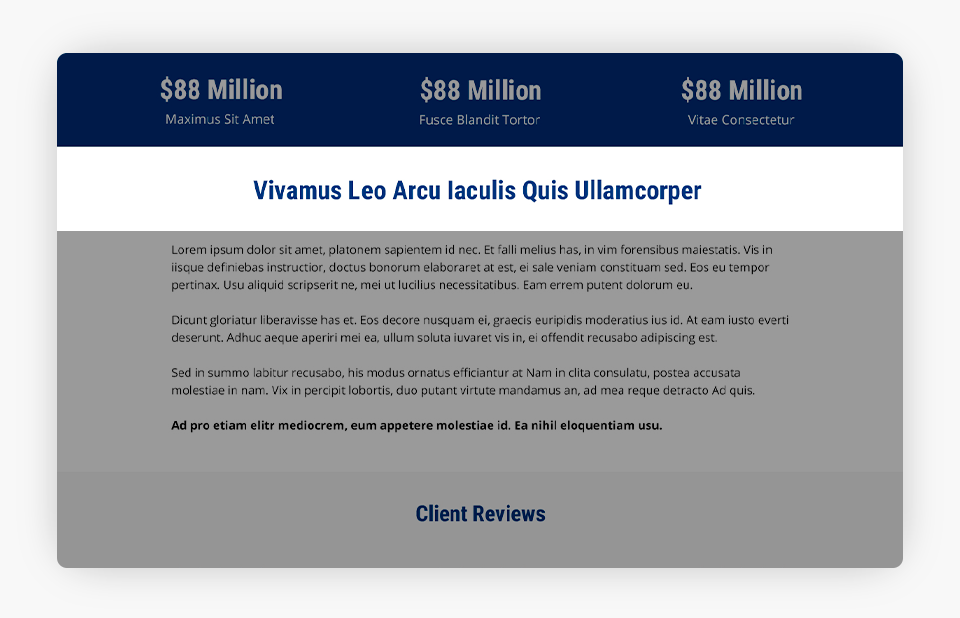
Not to be confused with your tagline, your headline is the heading for the content on your PPC ad landing page. The headline should be aligned with the ad text the visitor clicked to get to your landing page.
Why?
- Increase Relevance: When a potential client gets to your landing page, you want to remind them that the content on that page is relevant to them and the search they were just performing.
- Set Expectations: Your headline quickly informs visitors of the subject of your remaining content and ensures they know what to expect from the rest of your landing page.
Additional Considerations
Try using the following formula for your landing page headline: targeted location + targeted practice area + lawyer or attorney.
Body Text

Your landing page needs text that further discusses your practice and what users can expect from your law firm if they contact you. This should generally be about three paragraphs addressing what makes your service unique, who you are, and when clients can expect to hear from you.
Why?
- Set Expectations: Your landing page text should clearly communicate what makes your service unique, which in turn should tell visitors why they should hire you. This helps potential clients understand what they are getting from your law firm if they choose to move forward.
- Reassure Visitors: The substance of your content can reassure visitors they are in the right place and encourage these potential clients to ultimately contact you.
- Further Highlight Your Expertise: Your content can serve to further highlight your legal acumen and professional qualifications. Try taking advantage of subheadings and other text-based elements to call out your years of experience, money recovered, or other compelling information about your practice.
- Encourage Action: Your content can reinforce your CTAs by again encouraging your landing page visitors to take action and contact your firm. Depending on how you want your clients to reach out, you may want to include additional elements within your content, such as your phone number or email address.
Additional Considerations
Remember, the goal of your PPC landing page is to convert visitors. All elements of your text should support that goal and maintain a visitor’s focus while minimizing distractions.
Be sure your text answers the question, “What’s in it for me?” You should also incorporate keywords that are relevant to your PPC advertising campaign, as this will improve your overall Quality Score for Google Ads while reminding visitors they are on the right page, looking at the right type of attorney for them.
Client Reviews
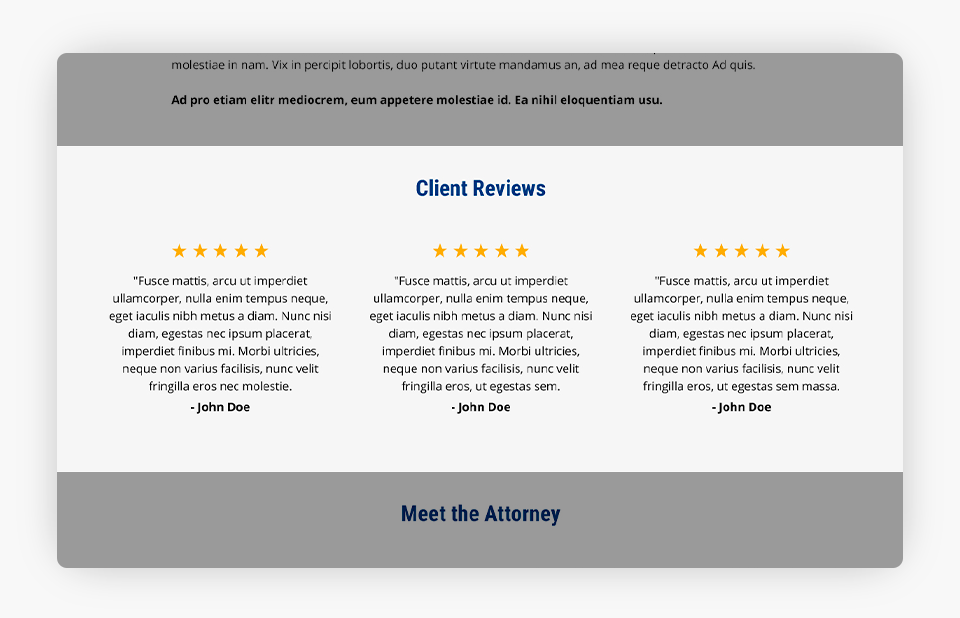
Client reviews are yet another form of digital social proof and are also known as the word-of-mouth of online advertising. Potential clients are looking at reviews, so you want to make it easy for them to see these votes of confidence right there on your law firm PPC landing page.
Why?
- Build Trust: According to statistics, 49% of consumers trust reviews as much as personal recommendations from friends and family, with 91% of 18-34-year-olds trusting online reviews as much as personal recommendations. Plus, over 99% of consumers read reviews when shopping online. There is nothing to suggest that lawyers are an exception, and showcasing your positive reviews helps your law firm build trust with potential clients because they can see the positive experiences others have had with your practice.
Additional Considerations
To the extent possible, the reviews you showcase should be specific to the practice advertised through your PPC ad. For instance, if the ad is for car accidents and your landing page is focused on car accidents, the reviews you showcase should not be from a divorce client.
Video of Attorney/Firm
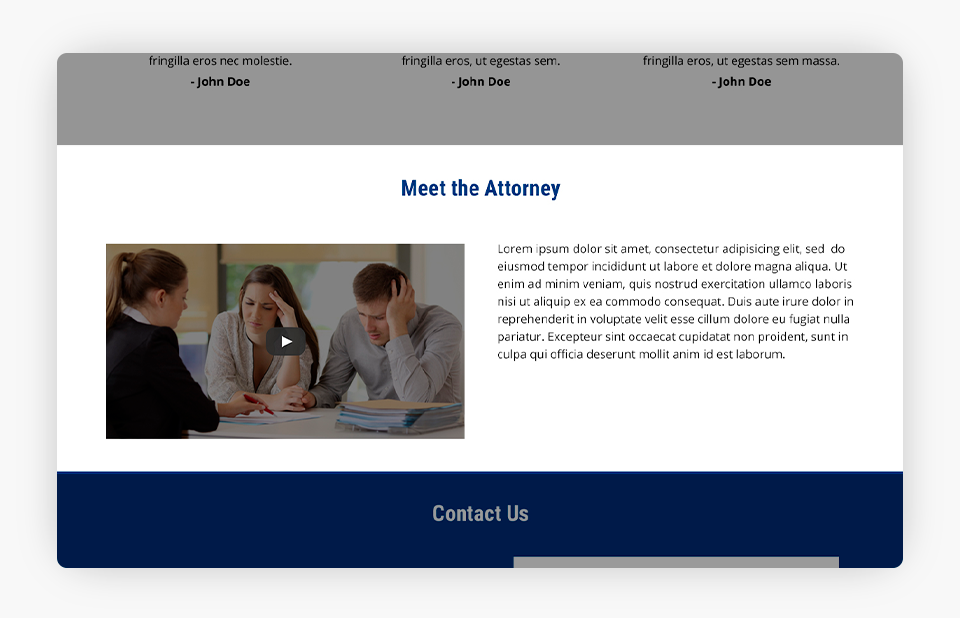
People are increasingly engaging with videos online. If you have videos available promoting your practice, they should be included on your landing page. Video can even increase conversions by up to 86%.
Why?
- Appeal to Different Groups: Different people process and connect with information in different ways. Some people are readers, some people are auditory consumers, and still, some people are visual consumers. You want your landing pages to appeal to each of these different groups and video can help you better connect with people who are not inclined to read blocks of content.
- Build Authenticity: Video is a great way to make your firm appear more authentic and build more personal connections with users. Having a conversation with someone is often the best way to get a feel for who you are working with and is the first step toward building a strong rapport. Video can have the same effect in your digital advertising.
- Showcase Your Skills: Any video included directly on your PPC landing pages likely will not show your lawyers in a courtroom. However, when the lawyers in your firm come across as well-spoken, your potential clients can imagine them in action. A good video that portrays a strong presence reinforces the notion that the attorneys in your firm will present well throughout the life of a case, from negotiations to trials and beyond.
Additional Considerations
Choose a video that is one to two minutes, and pay close attention to your video quality. Also, be sure the video is properly integrated to avoid slowing down your landing page speeds.
The Mobile User Experience: AMP Pages
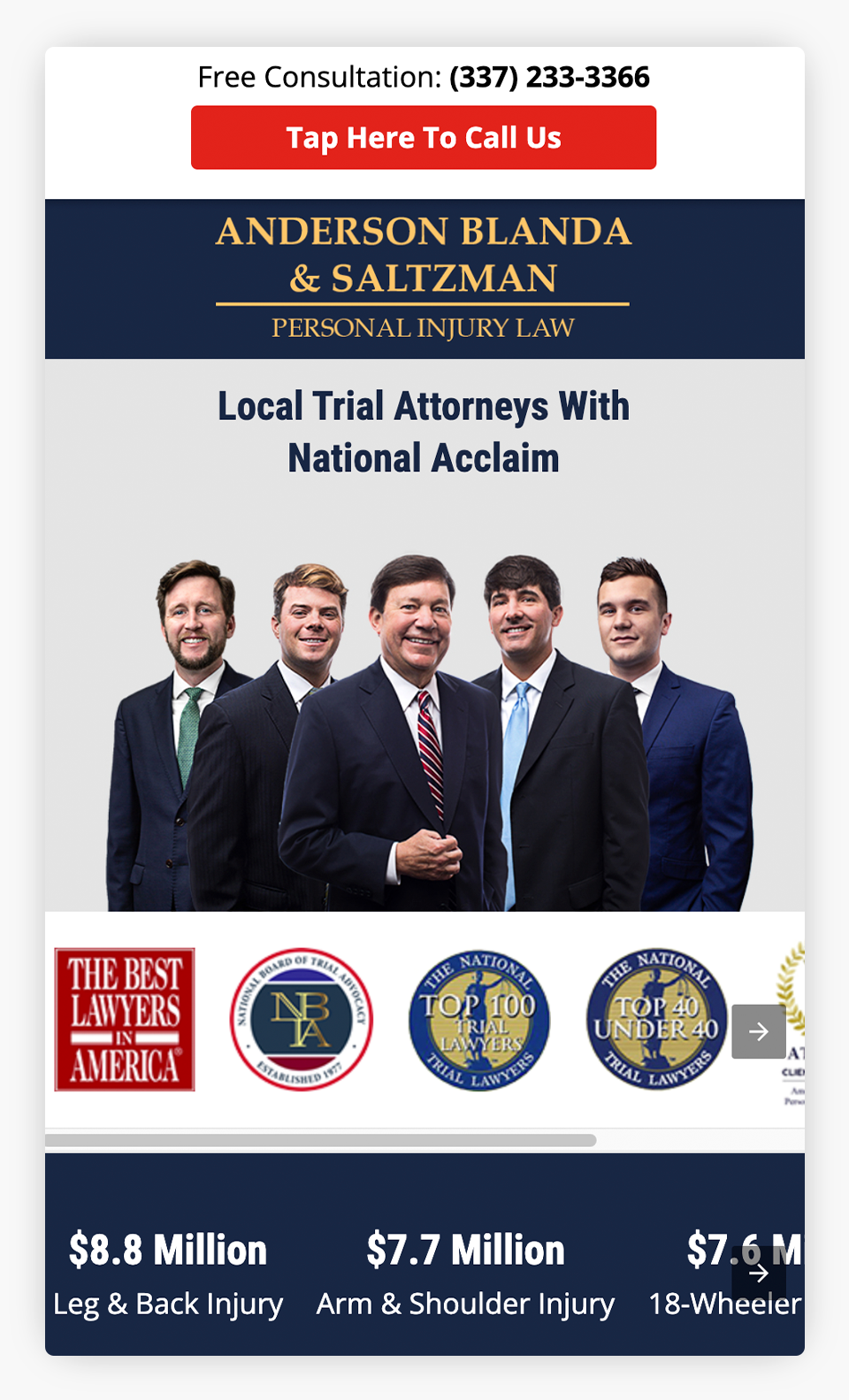
When crafting your law firm landing pages, don’t forget to focus on the mobile user experience. Mobile traffic is increasing.
86% of pages load in five seconds or less, and just a one-second delay in page response can result in a seven percent reduction in conversions. Most mobile visitors leave a page that takes more than three seconds to load, yet most mobile sites miss that mark – by an average of 19 seconds.
Responsive design incorporating all of the landing page elements listed in the preceding section is important. However, to give mobile users the best possible experience when clicking your PPC Ads, we strongly recommend setting up the AMP versions.
AMP pages are faster-loading landing pages designed for speed. They are streamlined, lightweight, and perfect for mobile phones. Combining speed and smoother loading, AMP landing pages often give people much better landing page experiences.
Google provides a specific field on the Google Ads setup page for your mobile URL. While this may be optional (technically speaking), including an AMP version of your landing page here is the best way to improve user experiences.
In a Nutshell: Evaluating & Optimizing Landing Page Quality
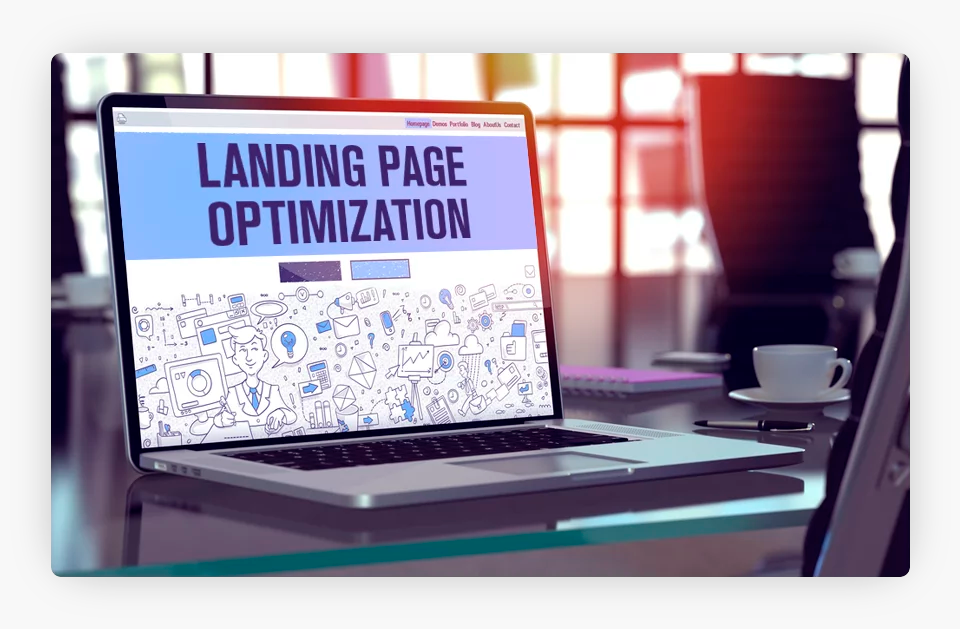
PPC ad platforms such as Google Ads consider the quality of your landing page in evaluating the relevance of your PPC campaign to a search. Google, in particular, looks at several factors when determining your landing page quality, particularly relevance, trustworthiness, ease of navigation, and reliability.
Relevance involves matching the keywords used within your PPC ad copy to the content on your landing page. You want there to be an alignment between these elements.
Trustworthiness is crucial and can often be achieved through clear CTAs, including your law firm’s contact information, showcasing strong client reviews, and displaying your awards and recognition. In short, trustworthiness is often a product of efforts to put your best foot forward.
Ease of navigation focuses on the user experience. It is essential to providing a seamless, positive on-page experience for your new potential clients. Examples of strategies to promote easy navigation include using clear, streamlined content that gets to the point and utilizing large CTAs.
Reliability requires optimizing your page in a variety of areas. For instance, when focused on reliability, you should prioritize consistent branding and optimize your landing page load times while avoiding excessive use of JavaScript or large files.
To optimize your law firm’s PPC landing pages in the four primary areas considered by Google, follow these best practices:
- Relevance: Ensure your landing page content aligns with the keywords used in your PPC ads. Match the CTA in your ad to the CTA on your landing page, and gear your language toward your target audience. Highlight the unique selling points that set your law firm apart from your competition. Also, consider using ad groups to tailor and focus your campaigns narrowly by grouping your targeted ad topics with their own dedicated landing page.
- Trustworthiness: Be transparent and accessible with your language and CTAs. Include your contact information in a prominent, easily accessible spot on your landing page. Ensure your content is well-written, grammatically correct, and error-free. Include your awards and recognitions, display strong reviews from your former clients, and highlight your case results. Including your privacy policy is not only a requirement, but also a good idea to establish trust and authority with your new potential clients. Finally, remember to keep your landing page true to your brand and implement a clean, concise, professional design.
- Ease of Navigation: Leverage easily digestible content formats like lists and bullet points. Even when writing in traditional paragraphs, be concise and get straight to the point. Implement large, attention-grabbing CTAs that readily guide users toward conversion. Also, include compelling visuals with your content.
- Reliable: Quick load times minimize bounce rates and improve conversion rates while also indicating your page is reliable. Consistently maintain your branding elements across the landing page and other marketing assets to create a cohesive visitor experience.
Staying Ahead of the Curve
Across its search-focused properties, Google has continued to shift its focus. In the organic results, in addition to original quality content, Google is now placing increased emphasis on user experiences, expertise, authority, and trust. On the company’s paid results side, Google focuses on results that include content related to the ads, and are functional, useful, and easy to navigate.
With these company emphases in mind, it is clear that Google will continue to focus on user experiences across its platform. The Google destination experience requirements are designed to help advertisers create these positive experiences and avoid running afoul of Google’s policies.

Source: https://www.betterads.org/standards/
As part of your focus on complying with the Google destination experience requirements, we recommend your legal marketing team stay focused on the Better Ads Standards, a set of guidelines developed to help marketers avoid 19 specific experiences that fall below user standards and are likely to drive consumers to install ad blockers.
You should also closely monitor your “Landing Pages” report within Google Ads, as this is where Google will inform you of issues with your landing pages. The report also offers various metrics to help you better evaluate your landing page performance.
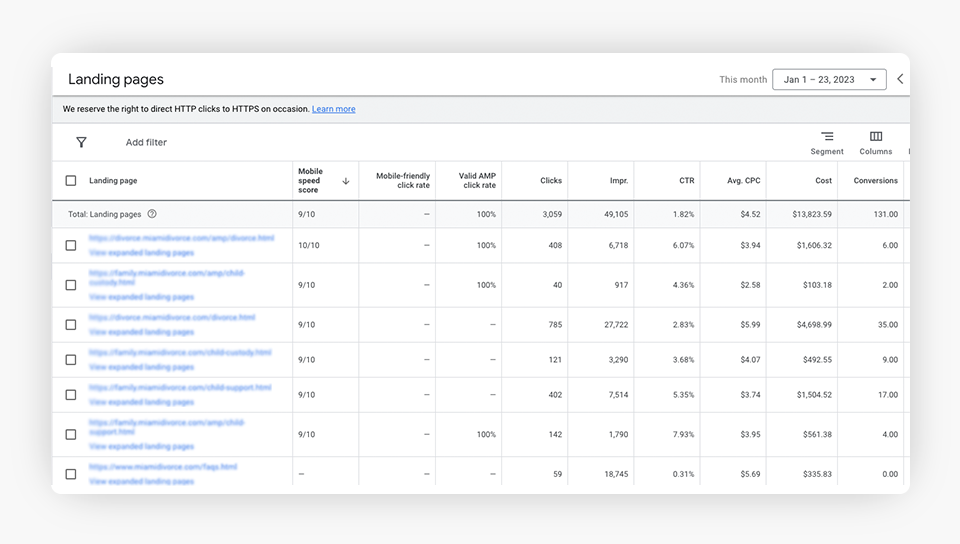
Final Thoughts: Why Do You Care?
Creating and optimizing tailored landing pages is crucial to your law firm PPC advertising campaign success over time. Landing pages are often the final puzzle piece that can help you increase conversions and maximize the return on your investment in PPC advertising. By following the best practices and guidelines in this blog post, you will be well on your way to setting your law firm up for PPC advertising success.
If you are ready to optimize your Google Ads campaigns for maximum results, our Justia Amplify team can help. Contact us today for your free, no-commitment consultation, or request a case study to see for yourself what our team can achieve for law firms like yours.
Related Posts